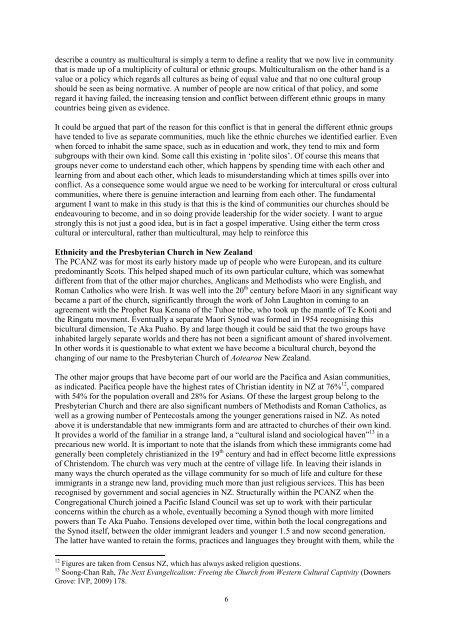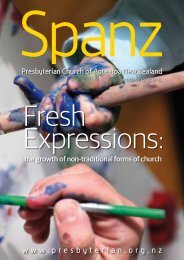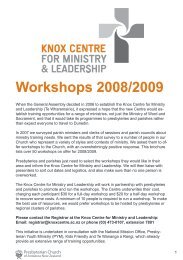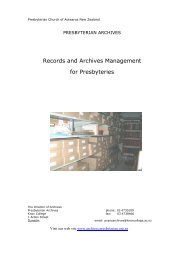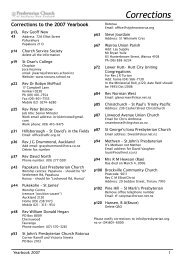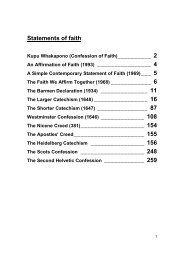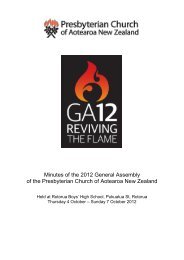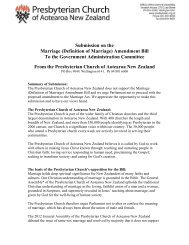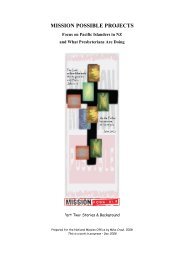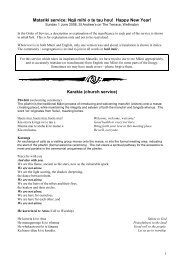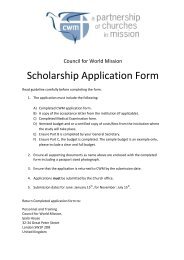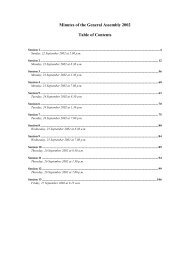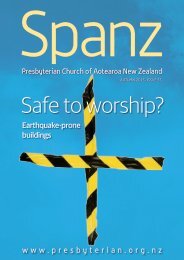Cultural diversity and unity in Christ: the Presbyterian Church of ...
Cultural diversity and unity in Christ: the Presbyterian Church of ...
Cultural diversity and unity in Christ: the Presbyterian Church of ...
You also want an ePaper? Increase the reach of your titles
YUMPU automatically turns print PDFs into web optimized ePapers that Google loves.
describe a country as multicultural is simply a term to def<strong>in</strong>e a reality that we now live <strong>in</strong> comm<strong>unity</strong><br />
that is made up <strong>of</strong> a multiplicity <strong>of</strong> cultural or ethnic groups. Multiculturalism on <strong>the</strong> o<strong>the</strong>r h<strong>and</strong> is a<br />
value or a policy which regards all cultures as be<strong>in</strong>g <strong>of</strong> equal value <strong>and</strong> that no one cultural group<br />
should be seen as be<strong>in</strong>g normative. A number <strong>of</strong> people are now critical <strong>of</strong> that policy, <strong>and</strong> some<br />
regard it hav<strong>in</strong>g failed, <strong>the</strong> <strong>in</strong>creas<strong>in</strong>g tension <strong>and</strong> conflict between different ethnic groups <strong>in</strong> many<br />
countries be<strong>in</strong>g given as evidence.<br />
It could be argued that part <strong>of</strong> <strong>the</strong> reason for this conflict is that <strong>in</strong> general <strong>the</strong> different ethnic groups<br />
have tended to live as separate communities, much like <strong>the</strong> ethnic churches we identified earlier. Even<br />
when forced to <strong>in</strong>habit <strong>the</strong> same space, such as <strong>in</strong> education <strong>and</strong> work, <strong>the</strong>y tend to mix <strong>and</strong> form<br />
subgroups with <strong>the</strong>ir own k<strong>in</strong>d. Some call this exist<strong>in</strong>g <strong>in</strong> ‘polite silos’. Of course this means that<br />
groups never come to underst<strong>and</strong> each o<strong>the</strong>r, which happens by spend<strong>in</strong>g time with each o<strong>the</strong>r <strong>and</strong><br />
learn<strong>in</strong>g from <strong>and</strong> about each o<strong>the</strong>r, which leads to misunderst<strong>and</strong><strong>in</strong>g which at times spills over <strong>in</strong>to<br />
conflict. As a consequence some would argue we need to be work<strong>in</strong>g for <strong>in</strong>tercultural or cross cultural<br />
communities, where <strong>the</strong>re is genu<strong>in</strong>e <strong>in</strong>teraction <strong>and</strong> learn<strong>in</strong>g from each o<strong>the</strong>r. The fundamental<br />
argument I want to make <strong>in</strong> this study is that this is <strong>the</strong> k<strong>in</strong>d <strong>of</strong> communities our churches should be<br />
endeavour<strong>in</strong>g to become, <strong>and</strong> <strong>in</strong> so do<strong>in</strong>g provide leadership for <strong>the</strong> wider society. I want to argue<br />
strongly this is not just a good idea, but is <strong>in</strong> fact a gospel imperative. Us<strong>in</strong>g ei<strong>the</strong>r <strong>the</strong> term cross<br />
cultural or <strong>in</strong>tercultural, ra<strong>the</strong>r than multicultural, may help to re<strong>in</strong>force this<br />
Ethnicity <strong>and</strong> <strong>the</strong> <strong>Presbyterian</strong> <strong>Church</strong> <strong>in</strong> New Zeal<strong>and</strong><br />
The PCANZ was for most its early history made up <strong>of</strong> people who were European, <strong>and</strong> its culture<br />
predom<strong>in</strong>antly Scots. This helped shaped much <strong>of</strong> its own particular culture, which was somewhat<br />
different from that <strong>of</strong> <strong>the</strong> o<strong>the</strong>r major churches, Anglicans <strong>and</strong> Methodists who were English, <strong>and</strong><br />
Roman Catholics who were Irish. It was well <strong>in</strong>to <strong>the</strong> 20 th century before Maori <strong>in</strong> any significant way<br />
became a part <strong>of</strong> <strong>the</strong> church, significantly through <strong>the</strong> work <strong>of</strong> John Laughton <strong>in</strong> com<strong>in</strong>g to an<br />
agreement with <strong>the</strong> Prophet Rua Kenana <strong>of</strong> <strong>the</strong> Tuhoe tribe, who took up <strong>the</strong> mantle <strong>of</strong> Te Kooti <strong>and</strong><br />
<strong>the</strong> R<strong>in</strong>gatu movment. Eventually a separate Maori Synod was formed <strong>in</strong> 1954 recognis<strong>in</strong>g this<br />
bicultural dimension, Te Aka Puaho. By <strong>and</strong> large though it could be said that <strong>the</strong> two groups have<br />
<strong>in</strong>habited largely separate worlds <strong>and</strong> <strong>the</strong>re has not been a significant amount <strong>of</strong> shared <strong>in</strong>volvement.<br />
In o<strong>the</strong>r words it is questionable to what extent we have become a bicultural church, beyond <strong>the</strong><br />
chang<strong>in</strong>g <strong>of</strong> our name to <strong>the</strong> <strong>Presbyterian</strong> <strong>Church</strong> <strong>of</strong> Aotearoa New Zeal<strong>and</strong>.<br />
The o<strong>the</strong>r major groups that have become part <strong>of</strong> our world are <strong>the</strong> Pacifica <strong>and</strong> Asian communities,<br />
as <strong>in</strong>dicated. Pacifica people have <strong>the</strong> highest rates <strong>of</strong> <strong>Christ</strong>ian identity <strong>in</strong> NZ at 76% 12 , compared<br />
with 54% for <strong>the</strong> population overall <strong>and</strong> 28% for Asians. Of <strong>the</strong>se <strong>the</strong> largest group belong to <strong>the</strong><br />
<strong>Presbyterian</strong> <strong>Church</strong> <strong>and</strong> <strong>the</strong>re are also significant numbers <strong>of</strong> Methodists <strong>and</strong> Roman Catholics, as<br />
well as a grow<strong>in</strong>g number <strong>of</strong> Pentecostals among <strong>the</strong> younger generations raised <strong>in</strong> NZ. As noted<br />
above it is underst<strong>and</strong>able that new immigrants form <strong>and</strong> are attracted to churches <strong>of</strong> <strong>the</strong>ir own k<strong>in</strong>d.<br />
It provides a world <strong>of</strong> <strong>the</strong> familiar <strong>in</strong> a strange l<strong>and</strong>, a “cultural isl<strong>and</strong> <strong>and</strong> sociological haven” 13 <strong>in</strong> a<br />
precarious new world. It is important to note that <strong>the</strong> isl<strong>and</strong>s from which <strong>the</strong>se immigrants come had<br />
generally been completely christianized <strong>in</strong> <strong>the</strong> 19 th century <strong>and</strong> had <strong>in</strong> effect become little expressions<br />
<strong>of</strong> <strong>Christ</strong>endom. The church was very much at <strong>the</strong> centre <strong>of</strong> village life. In leav<strong>in</strong>g <strong>the</strong>ir isl<strong>and</strong>s <strong>in</strong><br />
many ways <strong>the</strong> church operated as <strong>the</strong> village comm<strong>unity</strong> for so much <strong>of</strong> life <strong>and</strong> culture for <strong>the</strong>se<br />
immigrants <strong>in</strong> a strange new l<strong>and</strong>, provid<strong>in</strong>g much more than just religious services. This has been<br />
recognised by government <strong>and</strong> social agencies <strong>in</strong> NZ. Structurally with<strong>in</strong> <strong>the</strong> PCANZ when <strong>the</strong><br />
Congregational <strong>Church</strong> jo<strong>in</strong>ed a Pacific Isl<strong>and</strong> Council was set up to work with <strong>the</strong>ir particular<br />
concerns with<strong>in</strong> <strong>the</strong> church as a whole, eventually becom<strong>in</strong>g a Synod though with more limited<br />
powers than Te Aka Puaho. Tensions developed over time, with<strong>in</strong> both <strong>the</strong> local congregations <strong>and</strong><br />
<strong>the</strong> Synod itself, between <strong>the</strong> older immigrant leaders <strong>and</strong> younger 1.5 <strong>and</strong> now second generation.<br />
The latter have wanted to reta<strong>in</strong> <strong>the</strong> forms, practices <strong>and</strong> languages <strong>the</strong>y brought with <strong>the</strong>m, while <strong>the</strong><br />
12 Figures are taken from Census NZ, which has always asked religion questions.<br />
13 Soong-Chan Rah, The Next Evangelicalism: Free<strong>in</strong>g <strong>the</strong> <strong>Church</strong> from Western <strong>Cultural</strong> Captivity (Downers<br />
Grove: IVP, 2009) 178.<br />
6


